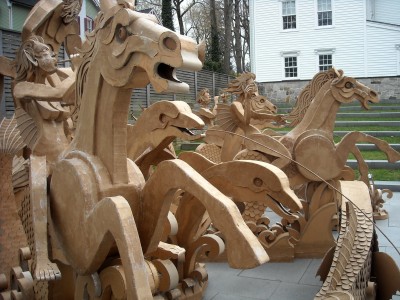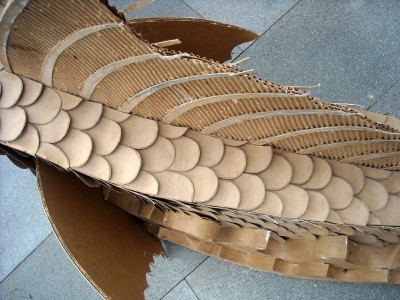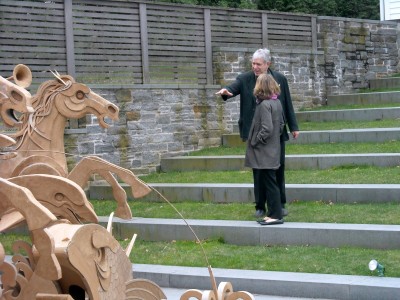Big Cardboard Box…or Eiffel Tower?
I just saw Olympia Stone’s “The Cardboard Bernini” at the Ridgefield Playhouse last night. Provocative and inciteful film about James Grashow, an extraordinary artist, and compelling personality. So I’m reposting this earler piece related to his process, and those of some other artists.
I’d scored a very tall, large, rectangular cardboard box. Tall, beige, and handsome. It had contained a tall, crazy- looking modern Italian light. Rather than throw the box out- such a nice,towering sturdy box-I dragged it over to my neighbor’s house where three very creative kids-Allie, Leila and Coco- would know just what to do with it.
And here’s how it went (my general translation from a firsthand account from Leila): “First we put pillows in it to make a clubhouse. Then when we got tired of that-well not tired exactly… we had a new idea. We decided to make an Eiffel tower, which Allie had heard about, that it was tall and in France. So, we went to the computer to find a picture of it. We printed out the pictures and used crayons to draw the Eiffel Tower on the box.
After a while we jumped on it, which smashed it up. So then we made it into a hotel because the flaps were like doors and windows. We painted Ariel on it, (the Little Mermaid).Then finally, we threw it out.”
Is this “childish thinking’”? Certainly. It’s also creative thinking. The girls know it’s not the real Eiffel Tower. So what! When things remind you of other things, and you follow the trail of creative crumbs, you can find your version of the Eiffel tower, among other possibilities…
Out of this free associating creative logic comes impressive dramas, narratives, artwork and events, creations. And lots of fun.
Enjoy this marvelous video to see what can happens when an inventive child, Caine Monroy, meets cardboard, with help from smart and caring adults:
We’re encouraged to do this when we’re kids, and are usually gently encouraged out of it as we grow up. Because in order to become solid citizens we need to develop the sequential planning and critical thinking associated with left hemisphere brain functioning. That largely becomes the goal.
And if we were using only an in- the- moment- Eiffel- tower- making thought process we might truly wind up living in a box we think is the Eiffel tower!
What if we can use both capacities effectively? What if we need to come up with creative solutions as an adult? At work, or in our life in general. If we neglect our capacity for creative logic as an adult we’re stuck recycling every old pattern we were ever imprinted with.
We need both capacities, and fortunately our brains come with a nice two part set of cooperative hemispheres. Empirical logic, planning, evaluation, sequences on the left, the synthesis of new ideas, lyrical logic, in the moment creation on the right.
Think of the bat in one side, the ball in the other. They will play together and they need each other to play a good game.
Adult artists have a reason to maintain the out of bonds thinking they first experienced as children. It’s their source of inspiration; they need it to keep their artwork enjoyable, novel, diverting.
Let’s see how James Grashow, whose “Cardboard Fountain”, recently exhibited at the Aldrich Museum of Contemporary Art in Ridgefield, CT, approached his cardboard box. Here’s his thinking:
“Cardboard Fountain” seemed to be the perfect vehicle to express my growing awareness of our temporality. Water and cardboard cannot coexist together. The idea of a paper fountain is impossible, an oxymoron that speaks to the human dilemma. I wanted to make something heroic in concept and execution while fully aware of its poetic absurdity. I wanted to try to make something eternal out of cardboard…the Fountain was an irresistible project for me.”
It makes perfect poetic sense, to make a cardboard box into a replica of the Trevi Fountain, and then, leave it outside to rot, and ultimately, return back to the earth in a state of decomposition.
Do we hear the echo of children’s voices in back of this Grashow quote?
There’s a parallel here between James Grashows’ cardboard fountain, bound for destruction, ephemeral, serving to express an irresistible urge, and my neighbor’s kids whose Eiffel tower and other architectural iterations gave them pleasure, poetic shelter and is now part of recycled detritus. Creative logic.
Art is a wish fulfillment, a prayer, for something to be that can’t actually exist unless you do it. Just as it is for the scientist, engineer, the architect.The engineer, the architect is bound by empirical fact, while the artist is not. For the artist it’s not a monument in France or a working fountain, it’s the desire, your wish, your fascination that you manifest. Caine Monroy wanted his own arcade, and so, he made one!
What if your creative storehouse feels like it’s full of dust. Is it truly empty? (Of course not!) If you simply begin by welcoming your own adult brand of “childish thinking”, and treat it as an ongoing tool for invention, a universal game for the entire human family, you’ll have a different ball game entirely. New ideas will begin to appear, because you asked.
And what would you would do with your cardboard box? You can just fantasize, do the dreaming and thinking part, or make what you imagine. And you’re allowed to dream/do something silly. In fact, do that! Just daydreaming allows you to turn back time to retrieve childhood capacities. Just let your mind do that, and see what happens.



